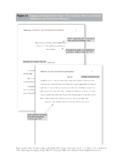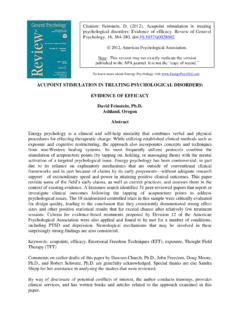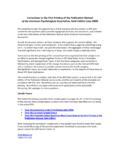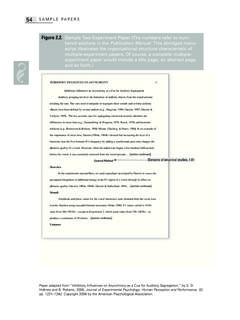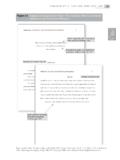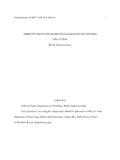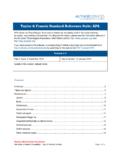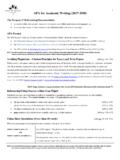Transcription of guidelines for authors - afhc.camp9.org
1 6 Journal of HUMANISTIC COUNSELING April 2015 Volume 54guidelines for authors 2015 by the American Counseling Association. All rights Journal of Humanistic Counseling (JHC) is the flagship journal of the Association for Humanistic Counseling (AHC), a division of the American Counseling Association (ACA). Submissions to JHC should emphasize the ways in which humanistic ideologies inform counsel-ing theory, practice, and outcomes. Because humanism has traditionally been associated with philosophical inquiry, JHC welcomes submissions on theoretical and philosophical issues in counseling. Manuscripts may take a variety of forms, such as conceptual essays, quantitative research, qualitative research, mixed methods research, or position OF MANUSCRIPTSM anuscripts are to be submitted electronically (in one attachment) in Microsoft Word format (.)
2 Doc) to Full instructions and support are available on the site, and a user ID and password can be obtained on the first visit. Support can be obtained by phone (888-503-1050), or via the red Get Help Now link in the upper right-hand corner of the log-in screen. For additional inquiries, contact the journal editor: Matthew E. Lemberger, JHC Editor, University of New Mexico, 128 Simpson Hall, MSC05 3040, 1 University of New Mexico, Albuquerque, NM 87131; phone: 505-277-4535; e-mail: Manuscripts are reviewed by at least two editorial board members and typi-cally undergo revision before final acceptance. The Editor makes final decisions regarding publication. Disposition is generally determined within 90 to 120 days of submission, and there is a maximum of three submissions for any submissions are blind peer reviewed.
3 Therefore, authors must submit a manuscript that contains no clues to the authors identity. Citations that may reveal the authors identities ( , in an extension of our previous work [citation of work with authors names] ) should be masked ( , [ authors , 2011 ]). The authors names, positions or titles, places of employ-ment, and mailing addresses should appear on one cover title page only, not in an author footnote. Other subsequent pages should include only the manuscript title in the header. authors submitting manuscripts to the journal should not simultaneously submit them to another journal, nor should manuscripts have been published elsewhere in substantially similar form or with substantially similar OF MANUSCRIPTSA uthors should carefully prepare their manuscripts in accordance with the following instructions:All manuscripts should be prepared according to the Publication Manual of the American Psychological Association (6th ed.)
4 ; American Psychological Association [APA], 2010). Manuscripts should be as concise as possible, yet sufficiently detailed to permit adequate communication and critical review. Consult the APA Publication Manual for specific guidelines regarding the format of the manuscript, abstract, citations and refer-ences, tables and figures, and other matters of editorial style. Tables and figures should be used only when essential. Selected Sections and Page Limitations for Manuscript SubmissionsTitle Page: The first page of the manuscript should be masked and contain only the title of the manuscript.**Note. Prepare a separate, supplemental file labeled Title Page and upload at the above website in addition to the blinded manuscript. This title page document should contain the article title, the names and affiliations of all coauthors, author notes or acknowledg-ments, and complete contact information of the corresponding author who will review page proofs (including complete mailing address and e-mail) in the following format:Author(s) Name only ( , no degrees or position titles listed), Department Name, University Name, at City (if applicable).
5 Author Name is now at Department Name, University Name, at City (if changed from above listing). Correspondence concerning this article should be addressed to Author Name, full mailing (including street or PO Box) address, City, State (using postal abbreviation), zip code (e-mail: on next page)Journal of HUMANISTIC COUNSELING April 2015 Volume 54 7 JHC guidelines for authors (Continued) Abstract: The abstract should express the central idea of the manuscript in nontechnical language. It should be on page 2 and is limited to 50 words. Keywords: Keywords should follow the abstract on page 2 and are limited to 5 words. Tables and Figures: No more than 3 tables and 2 figures with each manuscript will be accepted. Please be sure to indicate the table or figure callouts within the manuscripts. However, do not embed tables or figures within the body of the manuscript.
6 Each table or figure should be placed on a separate page following the reference list. Figure captions are to be on an attached page, as required by APA style. Figures (graphs, illustrations, line drawings) must be supplied in electronic format with a minimum resolution of 600 dots per inch (dpi) up to 1200 dpi. Halftone line screens should be a minimum of 300 dpi. JPEG or PDF files are preferred. (See APA Publication Manual, pp. 128 150, for more detailed information on table preparation and pp. 150 167 for further details on figure preparation.) References: References should follow the style detailed in the APA Publication Manual. Check all references for completeness, including year, volume number, and pages for journal citations. Make sure that all references mentioned in the text are listed in the reference section and vice versa and that the spelling of author names and years are consistent.
7 Footnotes or Endnotes: Do not use. Incorporate any information within the body of the : authors must also carefully follow APA Publication Manual guidelines for nondis-criminatory language regarding gender, sexual orientation, racial and ethnic identity, disabilities, and age. In addition, the terms counseling, counselor, and client are preferred, rather than their many synonyms. Provide an adequate description of the sample including not only gender, age range, and socioeconomic status, but also participants cultural, racial, and ethnic backgrounds. Discuss the clinical significance of results ( , effect size, narrative analyses).Page Limitations: The manuscript should be 12 to 30 double-spaced RequirementsLengthy quotations (generally, 400 cumulative words or more from one source) require written permission from the copyright holder for reproduction.
8 Previously published tables or figures that are used in their entirety, in part, or adapted also require written permission from the copyright holder for reproduction. It is the author s responsibility to secure such permission, and a copy of the publisher s written permission must be provided to the Editor immediately upon acceptance for MANUSCRIPTSA uthors will receive information for submitting a final copy of their manuscript upon ac-ceptance from the Editor. Your article cannot be published until the publisher (Wiley) has received the appropriate signed license agreement. Once the article has been finalized for print production, the corresponding author will receive an e-mail from Wiley s Author Services system which will ask them to log in and will present them with the appropriate license for completion.
9 Page proofs for review will be sent to the corresponding author only via e-mail. Receipt of Final PDF File Upon PublicationUpon publication of the journal, the corresponding author will be able to download a free PDF offprint of the article through the Author Services site. Information on the terms and conditions regarding the use of the final article PDF for the corresponding author and/or any coauthors is available on the site.
